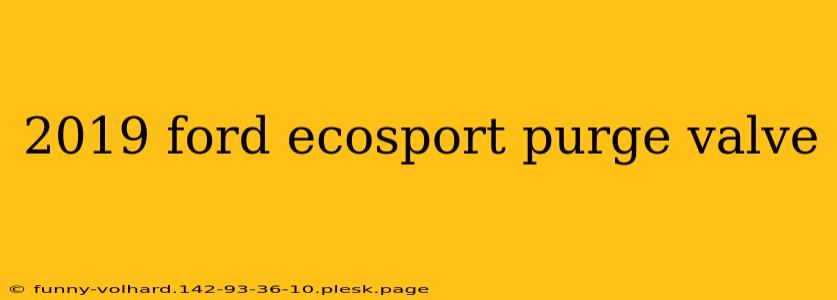The 2019 Ford EcoSport, like many modern vehicles, utilizes a purge valve as part of its evaporative emission control system (EVAP). This crucial component plays a vital role in preventing fuel vapors from escaping into the atmosphere, contributing to cleaner emissions and a healthier environment. However, like any mechanical part, the purge valve can malfunction, leading to potential issues with your vehicle's performance and emissions. This comprehensive guide will help you understand the function of the EcoSport's purge valve, troubleshoot potential problems, and guide you through the replacement process if necessary.
Understanding the Purge Valve's Function
The EVAP system in your 2019 Ford EcoSport is designed to capture fuel vapors that evaporate from the fuel tank and fuel lines. These vapors are stored in a charcoal canister. The purge valve is electrically controlled and opens and closes on demand from the vehicle's computer (Powertrain Control Module or PCM). When the engine is running and certain conditions are met (e.g., sufficient engine temperature, proper air-fuel ratio), the PCM signals the purge valve to open. This allows the stored fuel vapors to be drawn into the engine's intake manifold, where they are burned during combustion. This process prevents fuel vapors from escaping into the atmosphere.
Symptoms of a Faulty Purge Valve
A malfunctioning purge valve can manifest in several ways. Identifying these symptoms is the first step in diagnosing the problem. Common indicators include:
- Check Engine Light (CEL): This is often the first sign of a problem. The CEL will illuminate, and a diagnostic trouble code (DTC) related to the EVAP system will be stored in the PCM. A professional scan tool is needed to read these codes.
- Rough Idle: If the purge valve is stuck open, it can introduce excessive fuel vapor into the engine, leading to a rough or erratic idle.
- Poor Fuel Economy: A malfunctioning purge valve can negatively impact fuel efficiency, as the system may not be properly managing fuel vapor.
- Failed Emissions Test: A faulty purge valve can cause your vehicle to fail emissions testing due to increased hydrocarbon emissions.
Diagnosing the Purge Valve
While a professional mechanic can perform a comprehensive diagnosis using diagnostic tools, some preliminary checks can be undertaken:
- Visual Inspection: Carefully inspect the purge valve for any visible damage, such as cracks, leaks, or loose connections. Locate the purge valve (refer to your vehicle's repair manual for its exact location) and check for any obvious signs of wear or damage.
- Check Vacuum Lines: Inspect all vacuum lines connected to the purge valve for cracks, leaks, or disconnections. A damaged vacuum line can prevent proper operation of the valve.
Replacing the Purge Valve
Replacing the purge valve is typically a straightforward process, but it's essential to consult your vehicle's repair manual for specific instructions and torque specifications. Generally, the process involves:
- Disconnecting the Battery: Always disconnect the negative battery terminal before starting any repair work to prevent electrical shorts.
- Locating the Purge Valve: Refer to your repair manual to pinpoint the purge valve's location.
- Disconnecting Vacuum Lines and Electrical Connectors: Carefully disconnect any vacuum lines and electrical connectors attached to the valve.
- Removing the Purge Valve: Remove the purge valve using the appropriate tools. This may involve unscrewing it or removing mounting bolts.
- Installing the New Purge Valve: Install the new purge valve, ensuring all connections are securely made.
- Reconnecting the Battery: Reconnect the negative battery terminal.
- Clearing the DTC (if applicable): After installation, use a scan tool to clear any stored diagnostic trouble codes.
Disclaimer: This guide provides general information and should not be considered a substitute for professional advice from a qualified mechanic. Always consult your vehicle's repair manual for specific instructions and safety precautions before attempting any repairs. Improper repair can lead to further damage or injury.

